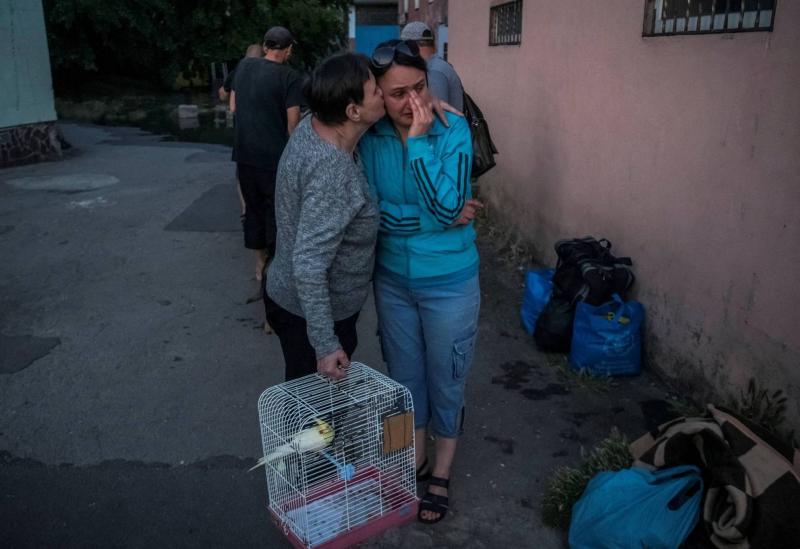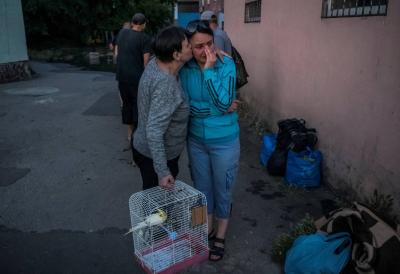Ukrainians have fled their homes as floodwaters submerged vast areas of southern Ukraine on Wednesday due to the destruction of the massive Kakhovka Dam along the frontline between Russian and Ukrainian forces, with each side blaming the other for the incident. Residents took to the streets, wading through the flooded areas while carrying their children on their shoulders and belongings in plastic bags, as rescuers used rubber boats to search areas where water levels had risen by nearly two meters.
Ukraine stated that the floods would deprive hundreds of thousands of access to drinking water and inundate agricultural land covering tens of thousands of hectares. Oleksandr Riva, who was evacuating his family's possessions from a village on the banks of the Dnipro River to a neighbor's house on elevated ground, stated, "If the water level rises another meter, we will lose our home." The roof of a house was seen swept away by the current.
The disaster of the Nova Kakhovka dam collapse coincides with an impending counteroffensive by Ukrainian forces, seen as the next key phase in the war. Both sides exchanged accusations of continued shelling in the flood-affected area and warned of landmines that had floated to the surface due to the floods.
Residents in the flood-affected region in southern Ukraine accused Russian forces of blowing up the dam, which they controlled from positions on the opposite bank. Riva added, "They hate us... they want to destroy the Ukrainian nation and destroy Ukraine itself."
Russia imposed a state of emergency in areas of the Kherson region that it controls, where many towns and villages are situated in low-lying lands below the dam. Residents there told Reuters via phone that Russian forces patrolling the streets threatened anyone who approached civilians. Ukrainian presidential office deputy head Oleksiy Kuleba mentioned that Ukraine expects floodwater levels to stop rising by the end of Wednesday after reaching about five meters the night before.
Authorities have evacuated 2,000 people so far from the Ukrainian-controlled part of the flood zone, where water levels have peaked in 17 residential areas housing 16,000 people. Oksana, a 53-year-old resident of a low-lying area in Kherson city, lamented, "The water has drowned everything — all the furniture, the refrigerator, the food, all the flowers — everything is floating. I don’t know what to do." The Russian news agency TASS reported that water levels could remain high in some areas for up to ten days.
The wide Dnipro River, which bisects Ukraine, forms the frontline in the south. The massive reservoir behind the dam was one of the country's major geographic features, irrigating large parts of Ukraine, one of the world's largest grain exporters, including the Crimea peninsula which Russia annexed in 2014. UN aid official Martin Griffiths told the Security Council that "the vast scale of the disaster will only become clear in the coming days."
Geneva Conventions explicitly prohibit the targeting of dams in wars, and neither side has provided public evidence to identify who is responsible for the collapse. Ukrainian President Volodymyr Zelensky, in a nighttime address, stated, "The whole world will know about this Russian war crime," describing it as an "environmental weapon of mass destruction." The United States stated it is still gathering evidence to determine responsibility, but emphasized Ukraine would have no reason to inflict such destruction upon itself.
Even as the evacuation continued, Russia shelled Ukrainian-controlled territories along the river. Explosions from artillery fire drove people attempting to flee to seek shelter in Kherson. Reuters reporters heard four blasts from artillery fire near a residential district that civilians were evacuating Tuesday evening. The regional governor reported one person was killed.
The reservoir provides water that cools the Zaporizhzhia reactors, Europe's largest nuclear power plant. The International Atomic Energy Agency stated that the plant should have enough water from a separate lake to cool its reactors for "a few months."




